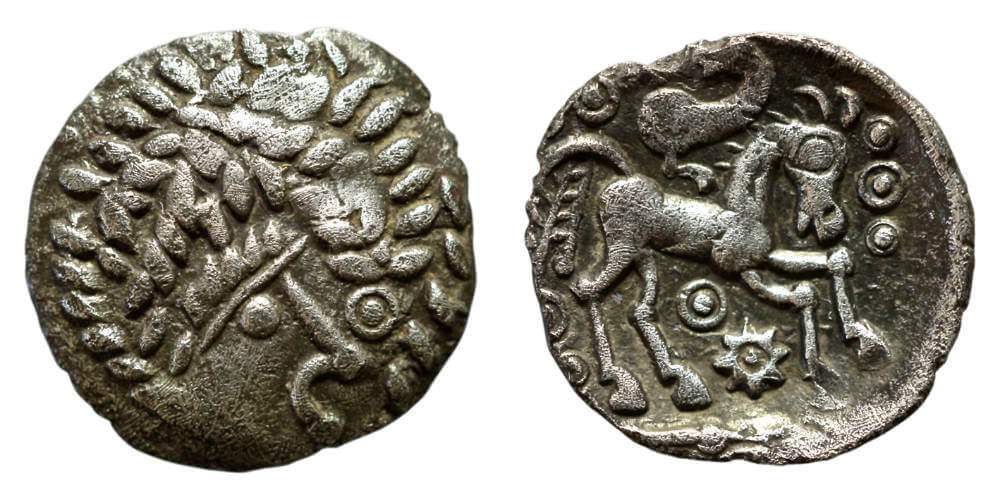The Most Beautiful: British Celtic Coins Selected by Tim Wright
The coins of pre-Roman Britain are as controversial as they are beautiful. We call them “Celtic”, assign them to “tribes” and attribute them to “kings”, even if these labels are fiercely debated. Early Gallo-Belgic and later Roman influences have led some to deem them inferior or derivative.
Let the coins do the talking. I have selected ten coins from those illustrated in my new book, British Celtic Coins – Art or Imitation? (Published by Spink in September) but struggled to choose between a much larger selection. For me, the strongest case for the collection and study of pre-Roman British coins is made by the coins themselves. So, I will let the coins do the talking.
Top 1
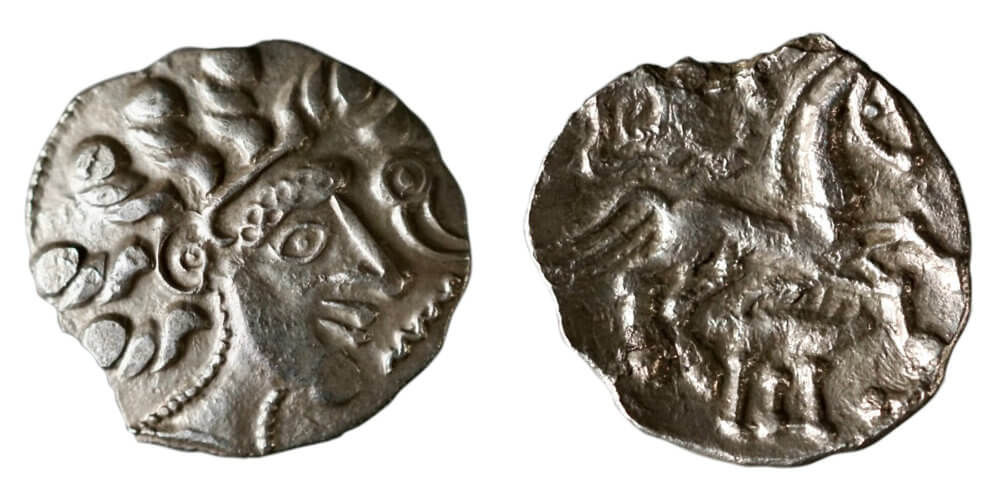
Southern, Regini, c. 50-30 BCE, uninscribed silver unit (ABC-). My top pick was only discovered after the publication of Ancient British Coins (ABC) in 2010, with this example unearthed last year. The obverse is a breath-taking female portrait, with an oval eye, long pointed nose, pin lips, a prominently rounded chin, and spiralling locks for hair; a duck is featured, hanging from a diademed helmet, with a snake, eel or worm below its bill. We simply cannot know who is portrayed, although a goddess is possible given the diadem and sacred duck. What we do know is that the image created is extraordinary and has been compared with that of the Egyptian queen Nefertiti by Chris Rudd. Wright, Coin 117.
Top 2
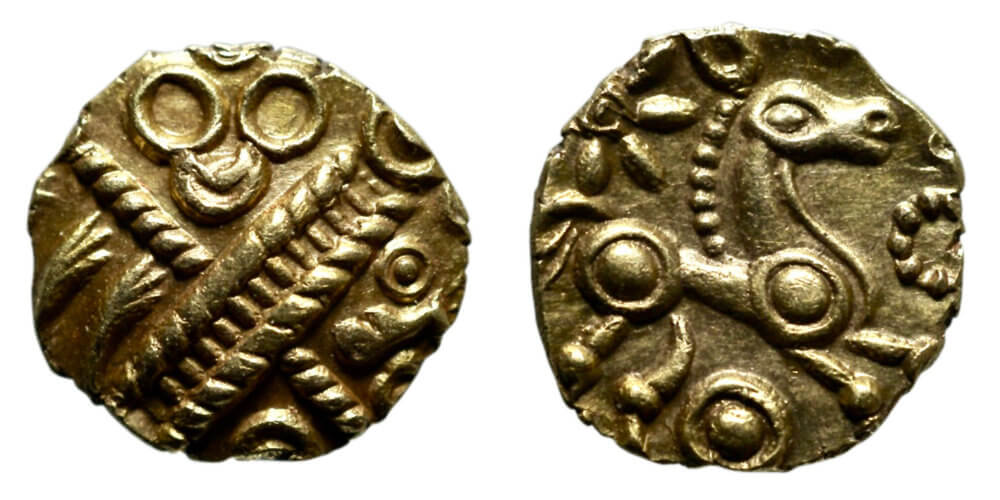
North Thames, Catuvellauni uninscribed gold quarter stater, c. 55-45 BCE (ABC 2466 variant). While the obverse reveals two opposing hidden-faces in a crossed wreath pattern, it is the wonderful equine reverse that most attracts me to this coin. A prancing pony is created using ringed pellets, elegant lines and a stylised head. The annulate theme of the fore and hindquarters is repeated in a ringed-pellet below, an oval-pellet eye, and a sense of motion is created by the sprawling legs and downward tilt of the body, while the youth is conveyed by the slightly oversized head and the neat, beaded mane. Wright, Coin 36.
Top 3

Kent, Cantiaci, c. 60-40 BCE, uninscribed silver unit (ABC-). Another recent discovery, this early silver unit from Kent has spectacular ‘heads’ and ‘tails’. The obverse is a bejewelled (possibly female) profile, with a large (all-seeing) eye, hair comprising tiny seahorses or snake-scrolls and a sheep in front (possibly indicating sacrifice). The reverse is of a vibrant sun-horse, in a playful scene that appears to celebrate the passing of the seasons (and celebration of spring?). Wright, Coin 67.
Top 4
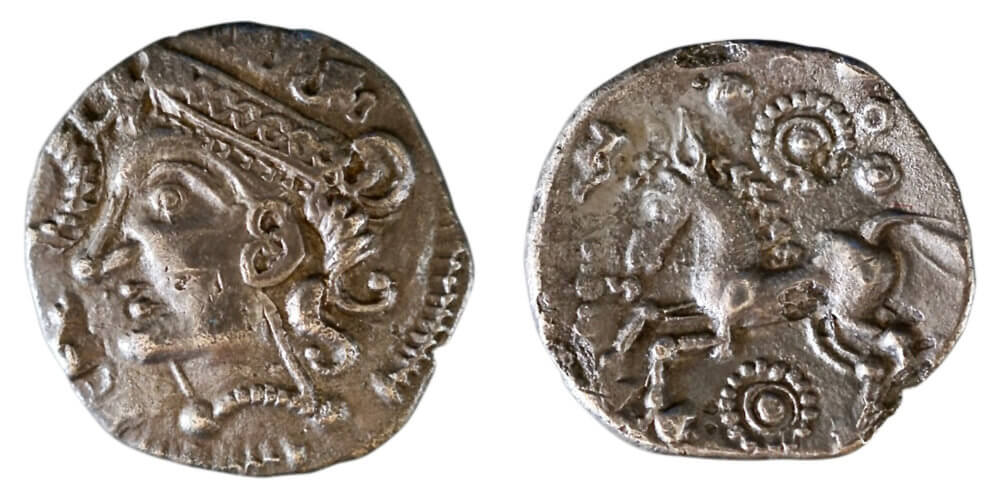
East Anglian, Iceni, c. 55-50 BCE, uninscribed silver unit (ABC-; Talbot Bury A, dies E/17). With some similarities to the first coin, the obverse shows a female head, with a long-pointed nose, a heart-shaped ear, a lunar crown and beaded neck-torc. In this case, we have a snake (only partially revealed in this example) rather than duck, possibly indicating the healing goddess, Sirona or the goddess of war Andraste. The ever-dramatic Dio Cassius has Boudica invoking Andraste before battle, by revealing a hare from her dress, more than a century after this coin. Wright, Coin 102.
Top 5
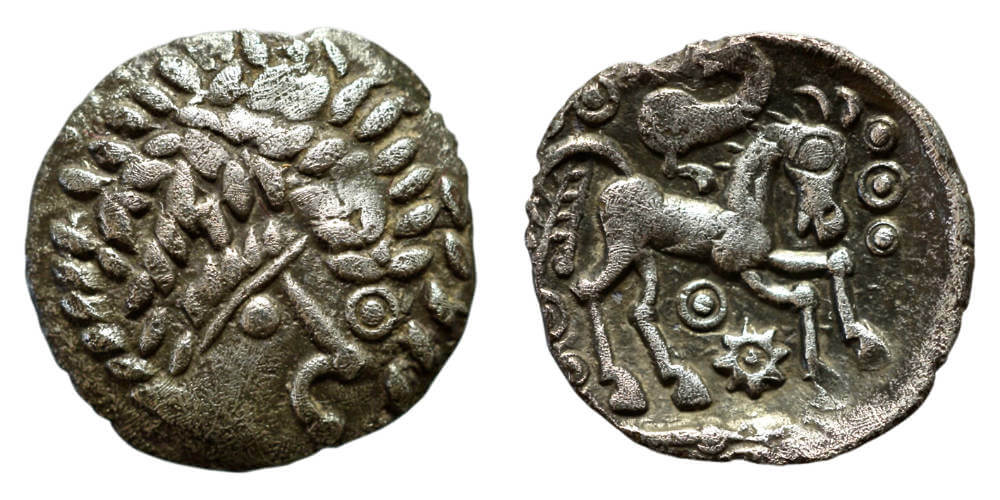
Southern, Regini, c. 55-45 BCE, uninscribed silver unit (ABC 659). Strabo and Caesar described Britons as nomadic herdsmen, living off the milk and meat of their livestock, while in reality they lived in settled rural communities, sowing crops and were preoccupied with fertility and the seasons. This coin exudes a bounteous harvest, with corn-ears forming exuberant hair that practically eclipses the diminutive pellet-and-line face of what may be a corn-god. The reverse is another playful sun-horse, with similarities to the reverse of the third coin. Wright, Coin 30.
Top 6
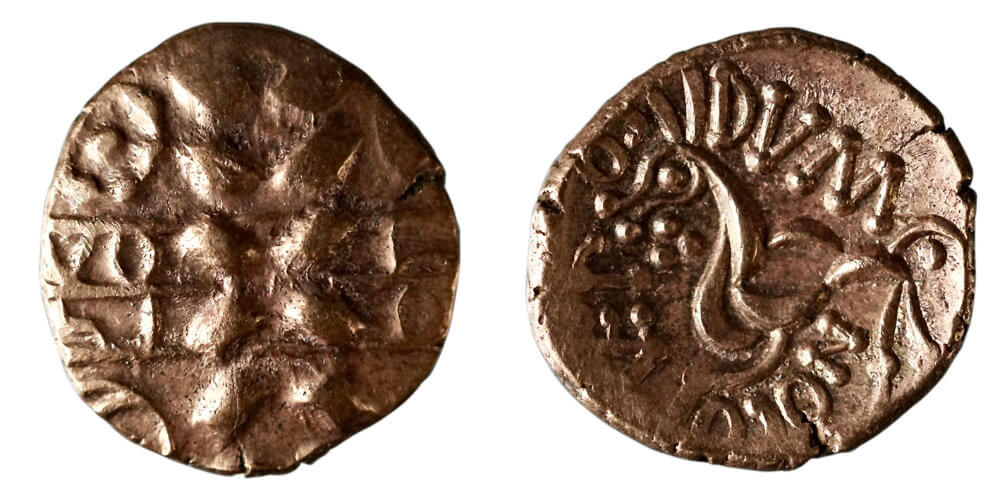
North Eastern, Corieltavi, Volisios Dumnocoveros, c. 35-40 CE, gold stater (ABC 1980). A much later coin than those previously illustrated, we have an inscribed obverse and a ‘dragon-like’ horse on the reverse. There is no corroboration of the obverse inscription, so it is unclear whether it is a king, elected leader, moneyer or even place. Unique to the North Eastern region, ‘lunate-horses’ are constructed of moon-crescents, which usually to convey a sense of the horse’s motion but which here reinforce the impression of dragon-flames. Wright, Coin 110.
Top 7
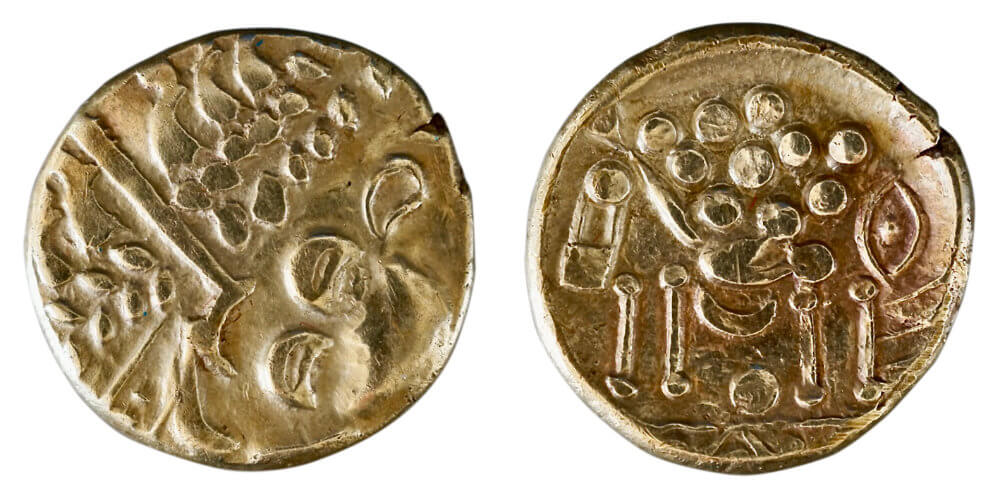
South Western, Durotriges, c. 60-50 BCE, uninscribed gold stater (ABC 482). The coins from the South Western region are some of the most abstract of pre-Roman British coins. Possibly inspired by their trading partners, the Morini in the Pas de Calais, they adopted the abstracted Macedonian prototype of Apollo on the obverse and a horse on the reverse, but continued the process to the point where the body of the horse is reduced to pellets, the legs to sticks, the tail a ‘coffee bean’ and the head a ‘safety-pin’. Wright, Coin 104.
Top 8
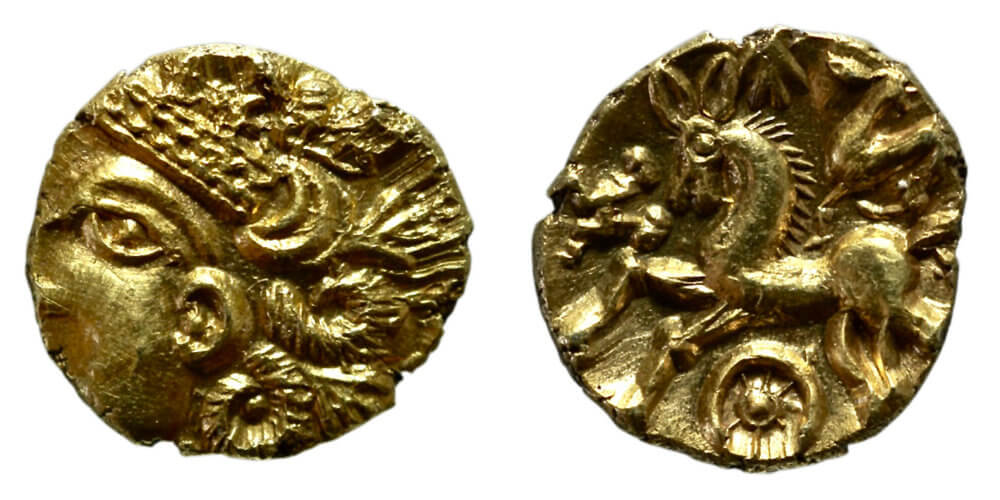
Southern, Regini, c. 55-50 BCE, uninscribed gold quarter stater (ABC 551). Even if the imagery of gold coins was relatively conservative, a contemporary coin went in the opposite direction of the previous coin, becoming less abstract. The obverse portrays a naturalistic face, enigmatically obscured by a partial strike (dies were generally larger than the coin), together with a series of corded curls that are reminiscent of the wreath designs of the prototypes. The reverse presents a recognisable horse, with bristling mane with pointed ears, that (again) has a dragon-like quality. Wright, Coin 29.
Top 9
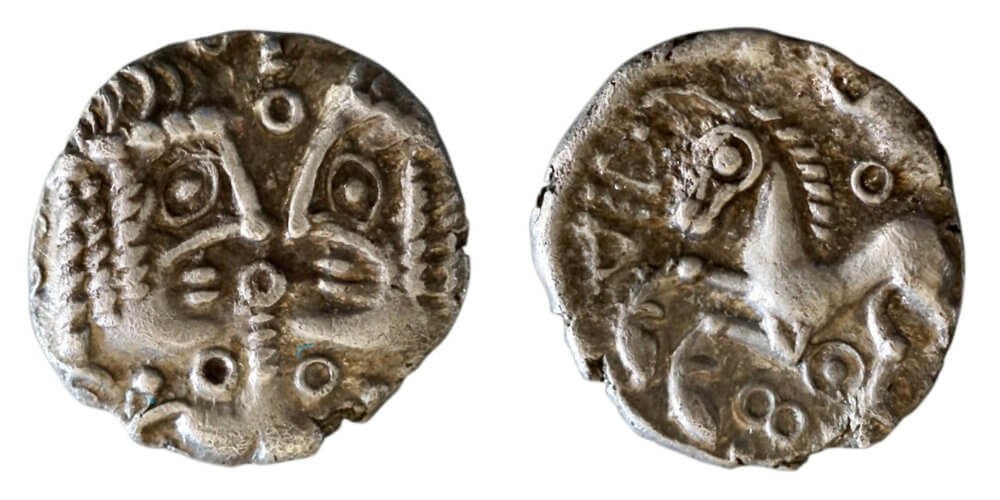
Kent, Cantiaci, c. 50-30 BCE, uninscribed silver unit (ABC 216). The defining feature of the next coin is a symmetrical design of two similar clean-shaven male heads, with beak-like noses, large eyes formed of ringed-pellets and line lips. The subject of twins is a Roman favourite, depicting the Dioscuri, the twins of Zeus, Castor and Pollux, the patrons of sports, war, and general good fortune. But here, the heads are facing rather than opposed (in the Janus head of the Dioscuri), and we have a bucranium (bull’s skull) below which reveals a hidden-face when rotated.. This original pre-Roman British coin became a prototype for an eighth century Anglo-Saxon sceatta. Wright, Coin 56.
Top 10
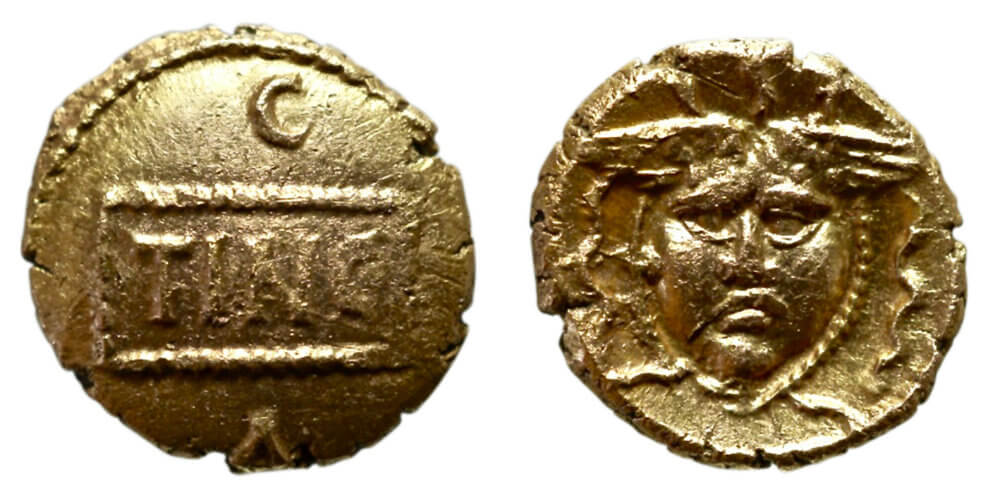
Southern, Regini & Atrebates, Tincomarus, c. 43-51 CE, gold quarter stater (ABC 1076) Our final coin is an inscribed coin from the later period of pre-Roman British coins. Tincomarus was one of the three ‘sons’ of Commius, and blatant propagandist, emblazoning his name on this obverse of this coin. Yet it is the reverse which is famous, depicting a gorgon or ‘Medusa’, incorporating the imagery of Rome and reflecting strong commercial, diplomatic and cultural connections for the south-eastern ‘dynasties’ at least in the period before Roman conquest. Wright, Coin 38.






